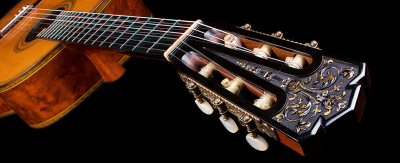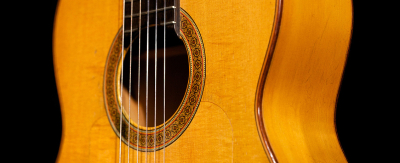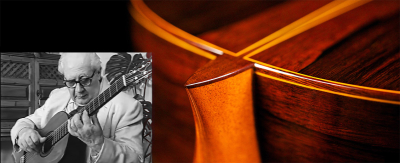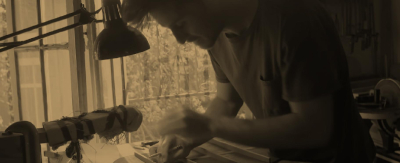Strings
A common question among players is “how often should I change my strings?”. That ultimately depends on how often you practice: if you play every day for an hour or more, re-stringing once a month will usually do the trick. If you play less, you can do it less often, and vice-versa. Lightly wiping the strings after each practice session may slightly prolong their longevity. But make sure you use a different cloth than the one you use to wipe your guitar. For a step-by-step guide to restringing a guitar, see “How to Properly Restring Your Classical or Nylon String Guitar“ in the FAQ section.
Re-stringing is a fairly straight forward process. But there are a few steps you can take which may help prolong the life of your guitar. The most important one is to avoid taking off all of the strings and then immediately installing the new set and tuning it to pitch.
The strings produce a considerable amount of tension on the soundboard and bridge, and releasing all of that tension suddenly, only to re-apply it a few minutes later can take its toll on the wood. Instead, remove one or two strings at a time; replace these 2 strings and then move on to the next two, and so on. This minimizes the “shock” that the wood encounters. Doing so reduces the risk of the bridge lifting off of the soundboard.
It is also a good idea to put a small piece of plastic or cardboard behind the bridge, in case the strings slip and slash against the soundboard. Finally, when you are done, use a pair of nail clippers to remove the excess string at the headstock. Planet Waves offers an ‘all-in-one’ string winder/clipper.
Like all material goods, wear and tear are factors that all guitars are exposed to. While it is obviously important to take good care of your instrument, it is also important to remember that guitars are built to be played, and therefore a few dents and scratches will undoubtedly occur over time. But as long as you are reasonably careful with your instrument these will be minor and should not affect your guitar’s performance.
Woods
The most critical factors with respect to wood care concern humidity, dryness, and temperature. As we mentioned in part one of this article, 40-70% relative humidity is the safe range for storing your guitar. For more detailed information, see the section of FAQ about humidification.
There are a few important measures you can take to further preserve and prolong the life of your guitar: a good case is essential; and a sturdy guitar stand is a good way of keeping your instrument safe when it’s out of its case or your cautious hands.
When it comes to normal wear and tear, a quick way of protecting your guitar’s wood (and finish) is by using a soft cloth as a right hand arm-rest to protect the edges of the guitar. Many players find it comfortable to use an old sock with the toes cut off to cover their elbow/forearm when wearing short-sleeved shirts. This not only protects the wood and finish but it makes it easier to slide your arm while playing. Also, remember to be mindful of shirts with buttons and metallic pens in your shirt pocket: you could add some nasty scratches to the back of your guitar.
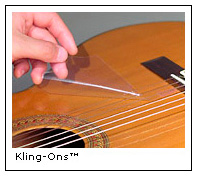
Also, if you are “heavy-handed”, a Kling-On may be of great value: it consists of a removable plastic film that works as a tap-plate. Do be careful to remove the Kling-On and wipe the guitar with a soft cloth when you’ve finished playing. Otherwise, a small cosmetic mark may be left on your soundboard. If you wish to install a permanent tap-plate, be sure to find one as thin as possible so that your soundboard’s vibration is not restricted. Ideally you should have a luthier install it for you to avoid any air bubbles from becoming trapped between the soundboard and the tap plate.
Finishes - French Polish/Lacquer
Two common questions guitar owners have on this subject are:
“Should I always use guitar polish when cleaning my guitar?” 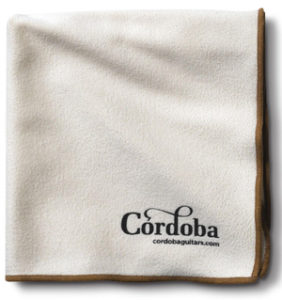 and “What type of polish should I use?”
and “What type of polish should I use?”
There are a couple of important things to remember regarding this. First, wiping your guitar regularly greatly minimizes the need for polishing. When you do find it necessary, consider that certain types of polish may not be well suited to your type of finish.
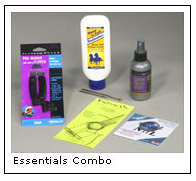
The finish on a guitar serves many different purposes: not only does it make the instrument visually appealing, but more importantly, it prevents dust, excessive moisture and oils from entering the wood. It also protects against scratches, and in some instances it may even prevent fine cracks from spreading. For these and other reasons it is important to keep the finish in good shape.
Fortunately, protecting the finish is a fairly easy thing to do. First of all, it is recommended that you lightly wipe your guitar after every practice session. This type of cleaning requires nothing fancy: a soft cloth is sufficient; although if you want to do a more thorough cleaning, a leather chamois works wonders: it is extra soft, and it easily removes fingerprints or sweat.
Lacquer
Two inherent characteristics of lacquer are its strength and durability, making it generally safe for polishing. Make sure that you use formulas specifically designated as ‘Guitar Polish’. While some people like to use car or furniture polish, many of these products contain abrasives and other ingredients which may scratch or otherwise damage your instrument. Guitar polishes are specially formulated to be gentle on lacquer finishes. GSI recommends Planet Waves’ “Polish Spray” and “Polish/Conditioner”. Remember: Always apply the polish to the cloth, never directly to the guitar.
French Polish (Shellac)
People who own guitars with shellac should be particularly mindful of polishes and conditioners. In general, it is usually safer to use a soft cloth lightly dampened with plain water. If you absolutely need to use polish, then STAY AWAY FROM SOLUTIONS THAT CONTAIN ALCOHOL. Shellac dissolves in alcohol; which means that along with any unwanted blemish, you may be removing your beautiful French polish. If you do find a formula that is alcohol-free, use it sparingly and be sure to spray it onto a cloth, and never directly onto the instrument.
Humidification
 Classical and flamenco guitars tend to be more susceptible to improper humidity than their steel-string and electric counterparts. With a little bit of knowledge and common sense a guitar can be kept in good shape, preserving not only its playability, but its aesthetic beauty and value as well.
Classical and flamenco guitars tend to be more susceptible to improper humidity than their steel-string and electric counterparts. With a little bit of knowledge and common sense a guitar can be kept in good shape, preserving not only its playability, but its aesthetic beauty and value as well.
The worst threats to a guitar’s ‘good health’ are: excessive dryness, excessive humidity, and sudden changes in temperature/humidity. However, it cannot be emphasized enough that excessive dryness is the most dangerous of the three.
Excessive dryness is a condition that can be caused by natural atmospheric conditions. However, living in a region with high humidity does not necessarily mean the guitar will not be exposed to dryness, because both air conditioning and heating systems can dry out the air.
Most high-quality classical and flamenco guitars are built in workshops where the relative humidity is maintained at approximately 50%. It is therefore recommended that your guitar be stored at this level. Storing your guitar in 40%-70% humidity is generally safe. But anything below 40% can potentially be dangerous. If humidity falls below 40% it is very common for the fingerboard to shrink, causing the frets stick out. If humidity drops below 30% warping and cracking could occur. Depending on the extent of the damage these problems can usually be fixed. If dryness is detected early enough, moving the guitar to a more humid environment will solve the problem. On the other hand, if damage is too advanced the frets may need to be filed down and/or the cracks repaired. The worst case scenario is when the damage is so advanced that the structural integrity of the instrument is compromised. At this point the best option is to take the instrument to an expert repair person to determine whether the instrument is salvageable.
As with all problems, prevention is the best medicine. There are two simple ways of preventing this type of damage from ever occurring. The first is using a humidifier in the room/house the guitar will be kept in. Humidifiers of this kind are sold by most department stores and they come in all shapes and sizes. The second, less intrusive method, is to humidify the case where the guitar will normally be stored. This not only is easier to monitor, but it is also more practical for people who travel with their instrument. If this is your method of choice the Humicase is a great option: it consists of a case with 2 built-in humidifiers, strategically placed to distribute humidity evenly throughout the interior and maintain it at the optimum level.
If you already own a good case you might consider using a case humidifier such as the Oasis Guitar Humidifier or the Oasis Plus Guitar Humidifier. These products for musical instrument cases work with a humidifier solution; this special liquid, together with the humidifier, helps regulate the humidity level much better than if you were to simply use a sponge with water inside your case. Do be careful to make sure the humidifier does not directly touch the guitar: direct contact with water could damage the wood/finish, or the humidifier itself could scratch the finish.
Hygrometers
Regardless of the type of humidification you employ, you should also consider a good dial or digital hygrometer to monitor humidity levels. GSI offers the Humicase Kit, which includes two custom-designed compact humidification units specially adapted for installation in your own guitar case (previously only available with the HumiCase), a mini digital hygro-thermometer, and an 8 oz. size of specially formulated HumiCase Activation Solution for use in the humidification units.
As stated earlier, two other conditions to avoid are excessive humidity and sudden changes in temperature/humidity. Damage from either of these circumstances is much less common, and usually less severe. The most common problem associated with excessive humidity is a slight loss in volume and quality of tone. This can be easily remedied by bringing the instrument back to the appropriate level of humidity. But, DO NOT TRY TO DO THIS QUICKLY OR OVERCOMPENSATE. Some people have tried to remedy this loss of volume/tone by ‘drying out’ the guitar in direct sunlight, only to pay a steep price for the sudden change in temperature and humidity the guitar experiences.
Simply put, avoid any extremes and use your common sense. Do not leave your guitar for long periods of time in direct sunlight; avoid car trunks (which can fluctuate from very hot to very cold quite quickly); do not hang your guitar on a wall (walls have much lower temperatures than the air around them), especially during winter months in cold areas; do not set the guitar next to sources of heat, etc. Very important: if your guitar is exposed to freezing temperatures, do not open the case immediately after going into a heated room! Let the guitar warm up to room temperature while it is still inside the case.
All this may sound like a great deal of trouble for a guitar, but given the size of your investment and the agony of discovering a crack in your fine instrument, we believe that a bit of effort in maintenance will be very much worth the time. If you follow these steps and take good care of your instrument, you should get a lifetime of enjoyment from your guitar.
How to Properly Restring Your Classical or Nylon String Guitar
 At the bridge, it is essential to create a “locking” loop to ensure against slippage. It is common to loop the plain nylon treble strings under two times and the wound strings at least once. This will ensure that as tension is applied to the string so it securely locks in place.
At the bridge, it is essential to create a “locking” loop to ensure against slippage. It is common to loop the plain nylon treble strings under two times and the wound strings at least once. This will ensure that as tension is applied to the string so it securely locks in place.
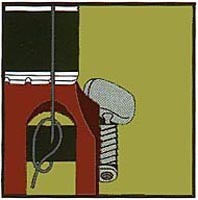 The locking hold – The most secure method of wrapping around the tuning peg is to bring the extra string back around and under the string as it winds around the peg. This is especially critical on strings that have no windings (plain steel or classical nylon treble strings, for instance).
The locking hold – The most secure method of wrapping around the tuning peg is to bring the extra string back around and under the string as it winds around the peg. This is especially critical on strings that have no windings (plain steel or classical nylon treble strings, for instance).
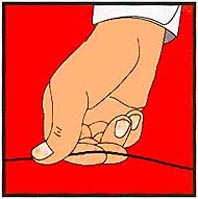 Use thumb and forefingers to gently stretch each string across its entire length. Tune the string to pitch and repeat the stretching procedure two or three times on each string. This will help stabilize your nylon strings more quickly. Care must be taken not to stretch the strings too aggressively. In general, nylon strings need more stretching time before they “settle in.”
Use thumb and forefingers to gently stretch each string across its entire length. Tune the string to pitch and repeat the stretching procedure two or three times on each string. This will help stabilize your nylon strings more quickly. Care must be taken not to stretch the strings too aggressively. In general, nylon strings need more stretching time before they “settle in.”
Note: It is common for classical plain nylon treble strings (1st, 2nd,& 3rd) to last longer than the wound bass strings (4th, 5th & 6th). Most professional classical guitarists will go through two to three sets of wound bass strings for every set of plain nylon treble strings.
Reprinted by permission of J. D’Addario & Company.

